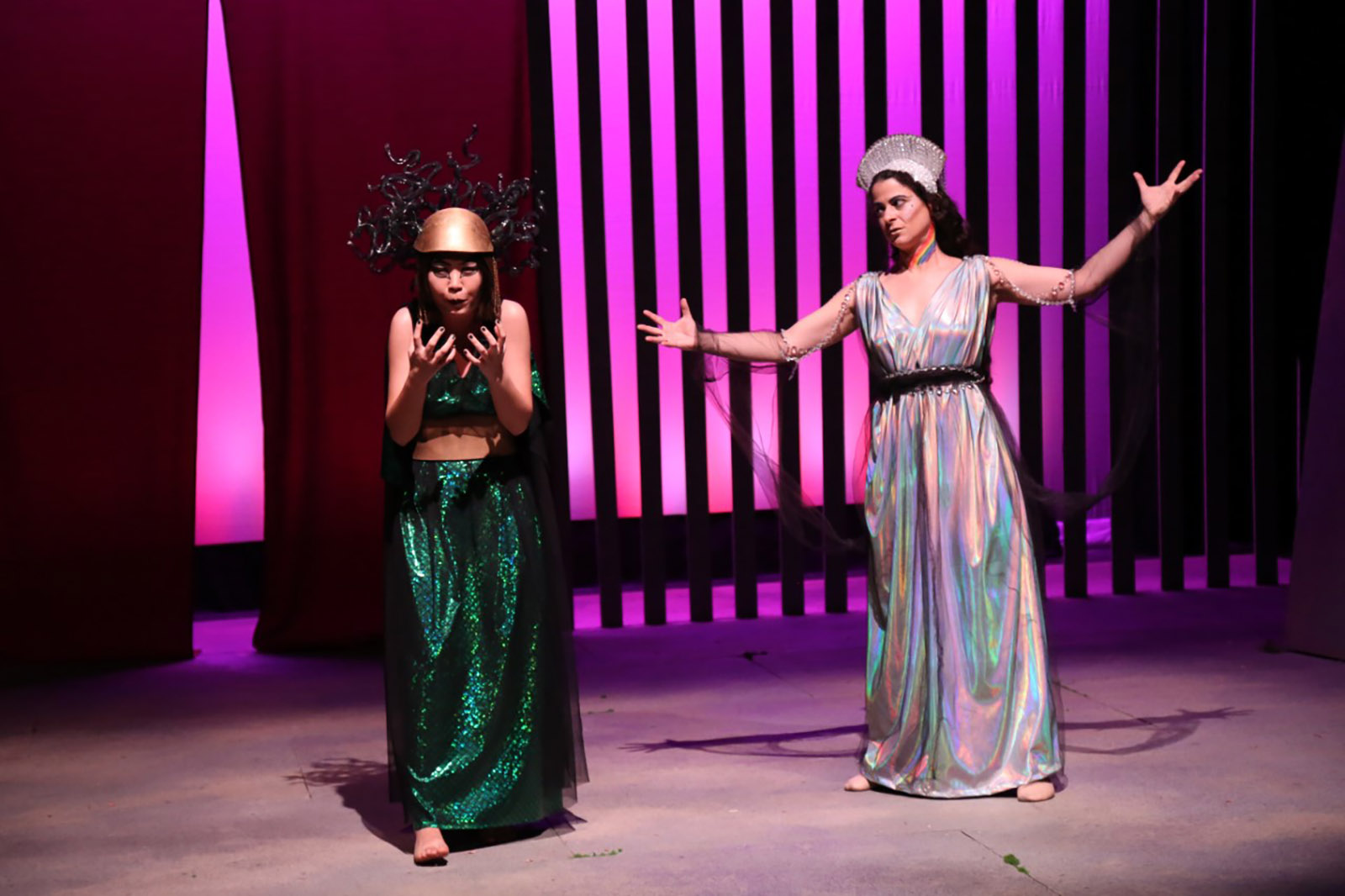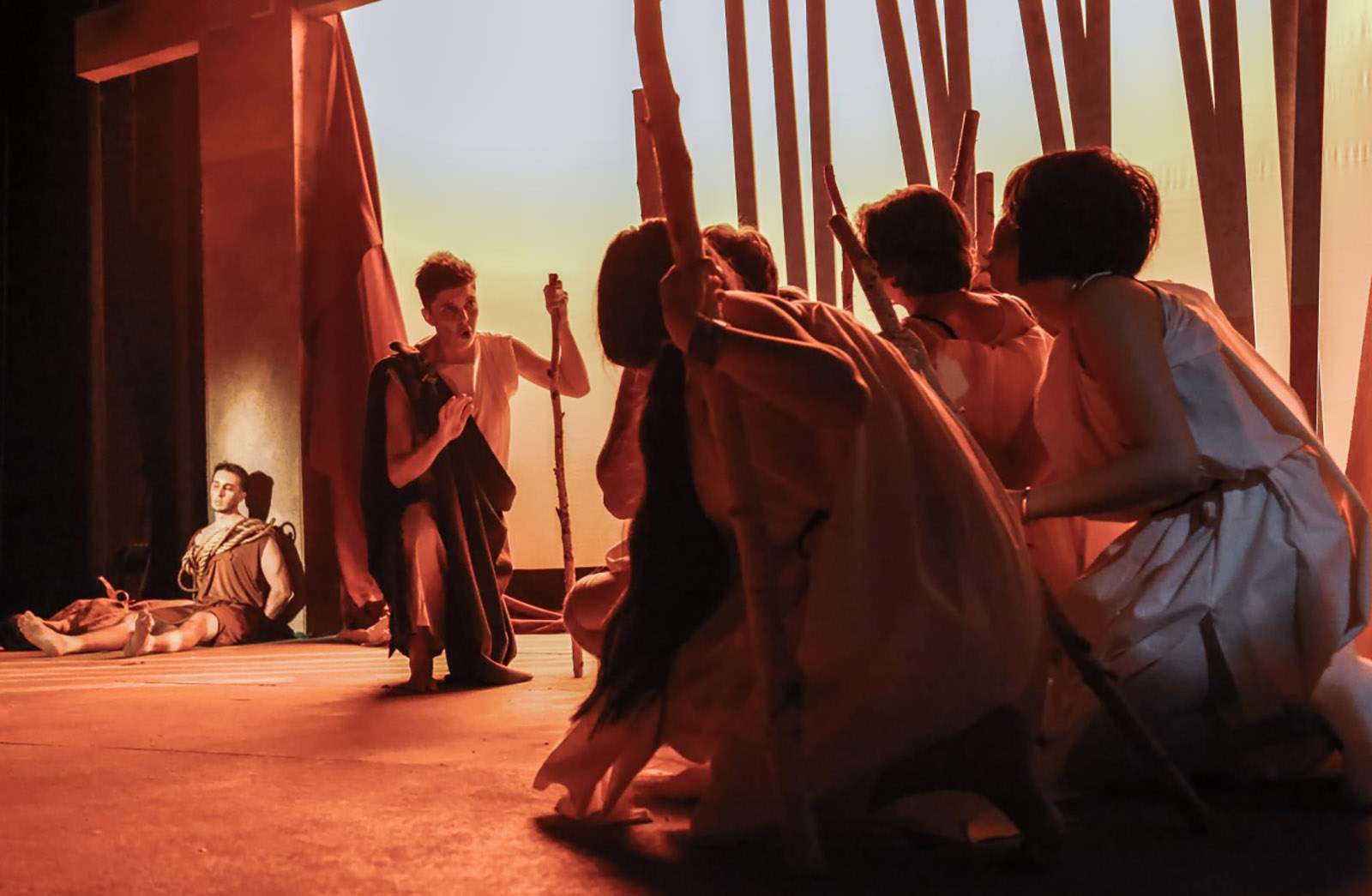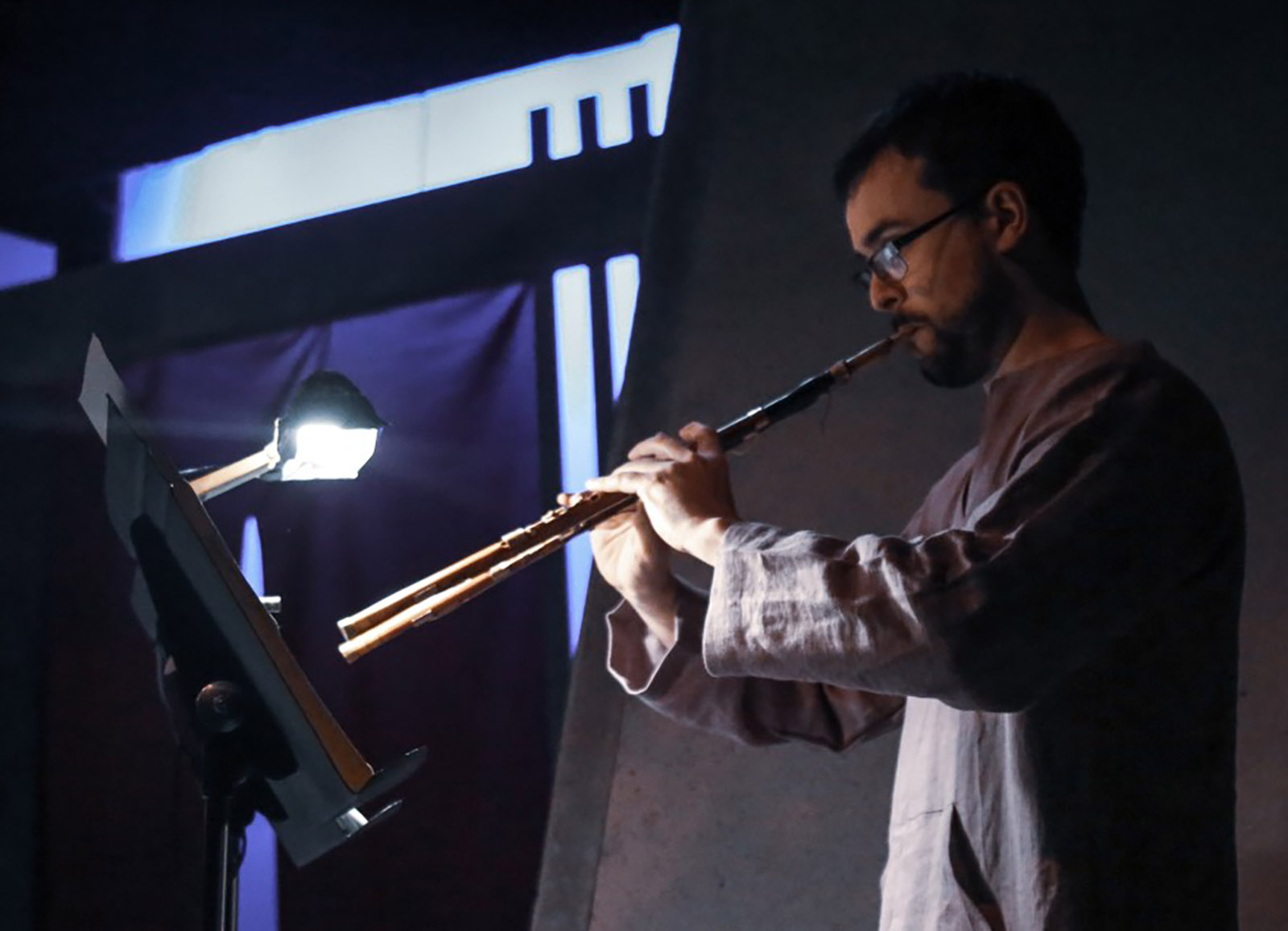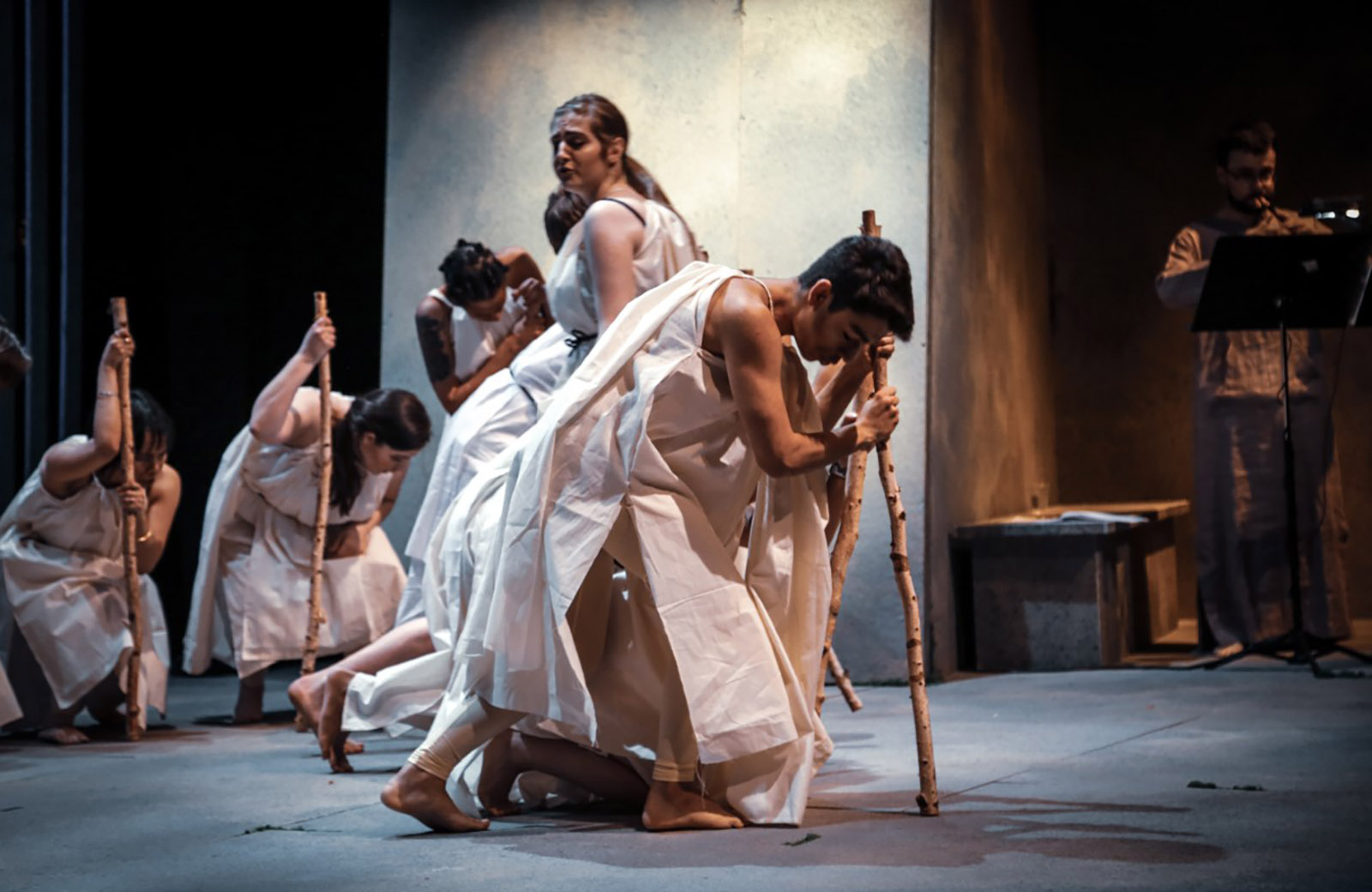Greek tragedy survives today as words on a page, but ancient performances were distinguished as much for music and dance as for speeches and dialogue. Tragic poets were composers as well as playwrights. The melodies of Euripides were so highly esteemed in the late fifth century BC that Athenian soldiers, taken prisoner on Sicily, could gain release by singing them for their captors. The aulos, a two-piped, reeded wind instrument, accompanied all choral odes, and its effect—at times solemn or languorous, at other times frenzied, to judge by surviving descriptions (Aristophanes suggested its sound was like the buzzing of wasps)—was deemed crucial to the mood of the drama. The musical dimension of ancient tragedy was long given up for lost, but a performance of Euripides’s Herakles at Barnard College, staged from April 4 to April 6, showed how much is being recovered, thanks to recent archeological finds and painstaking research.
The group behind this radical undertaking, Barnard Columbia Ancient Drama (BCAD), was founded in 1977 and is supported by a fund in memory of Matthew Alan Kramer, a Columbia engineering student who took part in its first production. The troupe puts on one classical play each year in the original Greek or Latin, with English subtitles. The performances are always in early spring (the season of the main tragic festival of ancient Athens), and draw principally on the talents of the Barnard and Columbia Classics departments, though they also enlist non-students. Its choral odes are set to original music and choreography, an ambitious undertaking for a small-scale theater series that has only ever tried for three-day runs.
Herakles, the group’s thirty-eighth production, seems to have particularly showcased the music of the aulos when it was first performed. The play’s titular hero, driven insane at the direction of the goddess Hera, slaughters his own family. In a crucial central scene, in which the personified figure of Madness (Lyssa in Greek) infects Herakles’s mind, Euripides’s language suggests that the sound of the aulos—heard no doubt in one of its more frenetic modes—conveyed her malign power. “I will pipe over you with terror,” Lyssa says to Herakles, using a verb coined from the word aulos. Such verbal cues suggested to Columbia PhD student Caleb Simone, a specialist in ancient music, that Herakles, a play not often seen on the modern stage, might be an ideal vehicle for a hugely ambitious feat: “the first modern staging of an ancient Greek tragedy… with a fully reconstructed score for tragedy’s original instrument,” as his program note asserts.
Three separate lines of research and reconstruction, each of which has seen recent breakthroughs, came together to create the Barnard production. An aulos of the type used in tragic theater had to be built; reeds that would fit it had to be cut and cured; and a musical score had to be composed for the play’s choral odes, using a system devised by another Columbia graduate student, Anna Conser, for relating Greek text to musical notes. Finally, a performer had to master the art of playing the aulos, a task that requires circular breathing—intake of air through the nose while the mouth is exhaling, to produce a continuous stream of sound—and, in the score for the current production of Herakles at least, the use of different fingerings for each of the aulos’s two pipes. There is much dispute about how the melodies of the two pipes were connected, but evidence suggests that in the late fifth century BC, when Herakles was originally staged, they would have formed a complex counterpoint.
Robin Howell, a woodwind craftsman interested in ancient instruments, built the aulos used in the Barnard production. Over past centuries, many ancient auloi have been recovered, but none, to judge by their borings and hole spacings, seemed suited for use in the theater. Then, in 2005, a construction project in the Greek city of Megara turned up a different variety of aulos, buried with its owner. Some of its holes could be opened or closed using a sliding sleeve, permitting changes of mode mid-performance—a feature well suited to the emotional vicissitudes of tragic drama. The Megara aulos itself seems too small for its sound to have filled a Greek theater, but based on its design Howell produced a larger replica. Auloi he had built previously, modeled on exemplars found in Egypt and at ancient Pydna, were played in two pathbreaking performances in 2017; one at Britain’s Ashmolean Museum, and another in a London adaptation of Aeschylus’s Suppliant Women.
While the discovery in Megara clarified the design of the aulos itself, the cane reeds that produced its sound—none of which have survived—presented other problems. Howell has been making reeds for reconstructed auloi for three decades, with varying results. In the past few years, close reading of De historia plantarum, a botanical work by the fourth-century BC philosopher Theophrastus that taught musicians how to harvest and prepare the best-sounding reeds, has helped to refine the process. In the course of his research, Caleb Simone found clues in this text not previously noticed by makers of reeds, discovering, for example, that the two reeds that fit together in each of the aulos’s mouthpieces must be cut from the same joint of a single cane stalk. Simone’s work in part enabled Howell to produce reeds for the theatrical aulos he had designed. The instrument was completed in February and put in the hands of Callum Armstrong, a British early music woodwind player who had been hired as accompanist for the choral odes of Herakles.
Advertisement
Meanwhile, back at Columbia, classicist Anna Conser was at work on a vocal score for Herakles that would incorporate new theories, including her own, about the melodic structure of Greek choral odes. Conser is a veteran of BCAD, co-directing its production of the Libation Bearers of Aeschylus in 2014 and directing Sophocles’s Women of Trachis two years later. During her years at Columbia, she has taken part in each annual production while also pursuing research into the musical structure of tragic choral odes, a topic that became the focus of her dissertation.
Furthering a line of inquiry begun by Armand D’Angour at Oxford, whose reconstructions of ancient music were performed at the Ashmolean concert, Conser became convinced that the accents on the words of these odes, preserved in extant Greek texts, carry substantial traces of the melodies that have mostly perished (a single papyrus scrap, containing scoring for a few lines of Euripides’s Orestes, was recovered in the 1890s). Scholars have long debated the relationship between these accents, which served scribes as a means of indicating the tonal pitch of spoken Greek, and the musical notes that accompanied them. Some deny any connection, citing the fact that, according to the ancient essayist Dionysius of Halicarnassus, responsive stanzas of the odes—marked in many texts as “strophes” and “antistrophes,” “turns” and “counter-turns”—matched one another in melody, even though their accents differ.
Conser tried a different approach. The few surviving scores of post-classical Greek poems reveal a pattern in which accents, while not matching musical notes precisely, nonetheless determine the direction of the melody line—its rises and falls. Such a pattern, Conser supposes, might well have been used in the classical age by the composers of Greek tragedies. Conser put her theory into practice with Herakles, composing choral music that relies on the melodic patterns she claims to have uncovered. Callum Armstrong then wrote music for the aulos to complement Conser’s vocal score, as intrepid chorus members, most of them undergraduates, began rehearsing the difficult musical phrasing. When Armstrong arrived from England and began rehearsing with the cast, the song of the aulos was heard, for the first time ever, in the US.
Seats for the four performances of Herakles sold out in advance as word spread of what was being attempted. Conser and Simone were recreating the aural dimension of a Greek tragedy, drawing on their own research and that of D’Angour, Howell, and other early music experts around the globe. Ancient music—at least, one plausible version—was being paired with modern staging and choreography (overseen by Jon Froelich, artistic director of the Cloud of Fools Theater Company, and Samuel Humphreys, a professional dancer). This was no mere exercise in antiquarianism, but an intriguing blend of the old and the new. “Our vision is not fully reconstructionist,” Simone remarks in his program note.
As the chorus of Theban elders hobbled onto the stage, leaning on their walking sticks, Armstrong launched into the first of his several “numbers.” His aulos, sounding something like a bagpipe but without its characteristic drone, brought out the somber mood of the old men, weighed down by time (they describe their own song as the “dirge of an ancient bird”). Later, the sliding sleeve of the theatrical aulos enabled Armstrong to shift musical modes, reflecting the play’s movement from triumph—the return of Herakles from Hades, and his victory over a cruel tyrant who threatens his family—to the despair caused by Hera’s cruel vengeance. During the interlude when Heracles is driven insane, Armstrong cut loose with an improvisatory aulos riff that seemed closer to Coltrane than Euripides, and a sound engineer gave the music a modern dimension with eerie reverb effects.
Advertisement
“Nobody has ever made head or tail of Greek music, and nobody ever will,” said the musicologist Wilfrid Perrett in 1932, quoting a classicist friend. “That way madness lies.” In a sense this last statement was on the mark, for it was the “piping” of Madness, the malign deity of Euripides’s Herakles, that BCAD’s director and composers set out to replicate. Thanks to their efforts, a handful of lucky New Yorkers witnessed something remarkable this month: the awakening of a theatrical tradition that has lain dormant for more than two millennia.
Herakles, by Euripides, was performed by Barnard Columbia Ancient Drama and directed by Caleb Simone, at the Minor Latham Playhouse, April 4–6, 2019.






